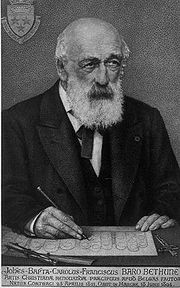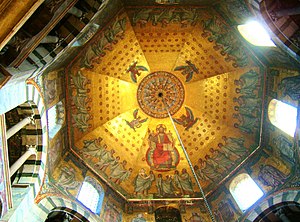Jean-Baptiste Bethune
Jean-Baptiste Bethune (born April 25, 1821 in Kortrijk , † June 18, 1894 in Kortrijk-Marke) was a Belgian architect, artist and designer and a central figure in the renewal of the Belgian and Catholic Gothic . He was referred to by some as the " Pugin of Belgium".
Life
Jean-Baptiste Bethune was born into a wealthy Flemish family of French origin. He and his relatives were avowed Catholics and mostly employed in politics and the public service. The Bethune family had been ennobled by the Belgian king and since then had the “de” in their name.
Jean-Baptiste Bethune first studied law at the Catholic University of Leuven and then entered the public service as the Provincial Council of West Flanders in Bruges . He received his artistic training at the Academie voor Schone Kunsten in Kortrijk (his teachers were L. Verhaegen and Jules Victor Génisson). Paul Lauters introduced him to landscape painting , while the sculptor CH Geerts (1807–1855) introduced him to the art of sculpture .
In 1842 and 1843, as well as 1850, Bethune visited England and met Augustus Welby Pugin , advocate of the revival of the Gothic in England and also a staunch Catholic. The encounter with Pugin and his creations increased Bethune's interest in architecture and applied art. Based on Pugin and his followers, Bethune developed the idea that a revival of the arts of the “Christian” world of the Middle Ages could also shape a new Christian society.
Back in Belgium, Bethune was encouraged by Canon C. Karton to participate in the development of a “real” Christian art. Gradually he began to make his own designs, and in 1854 he even founded his own stained glass workshop , supported by the colored glass manufacturer J. Hardman (1812–67) .
In 1862, Bethune co-founded the Saint-Luc Schools (Dutch Sint-Lucasscholen ), the Catholic counterpart to the official academies, which trained architects in the religious spirit of the Gothic tradition. The first of these schools, which also taught handicraft skills for colored glass work, wood carving, painting, and gold and silver work, opened in Ghent in 1863 . The aim was to ensure that craftsmen could handle all of the decoration of a newly built Gothic church.
As a teacher and patron of the Gilde de Saint-Thomas et de Saint-Luc Archaeological Society, founded in 1863 , Bethune had a decisive influence on the revival of the Gothic style in Belgium. Among those he taught or influenced were architects Joris Helleputte and Louis Cloquet. He also maintained contacts abroad and was highly valued by contemporaries such as Pierre Cuypers , Edward Welby Pugin , August Reichensperger and Eduard Jakob von Steinle .
plant
In his architectural work, Bethune adopted the formal vocabulary of the typical late medieval brick architecture of Flanders and in particular of the city of Bruges. His students and his followers adopted and spread this attitude, which, together with Bethune's strong Catholic inspiration and connection to England, is characteristic of the difference from neo-Gothic architecture, which was defended in Belgium by the academies and the followers of Viollet-le-Duc . The latter school was more interested in restoration, while new designs were largely influenced by the Gothic architecture of France and Brabant. These designs were more based on civil romanticism and lacked the religious and social idealism of Bethune and its Saint Luc schools.
Aside from the architectural work, Bethune's extensive oeuvre includes designs for virtually all the performing and decorative arts. His designs can be found in many European countries. The level of his work can best be seen in projects in which all art forms are represented. These include, for example, Loppem Castle, the Vivenkapelle complex (consisting of a church, presbytery and monastery school) and the large complex of Maredsous Abbey. Bethune's designs have a strong architectural, archaeological and didactic character. His stained glass windows (e.g. in the cathedrals of Bruges, Ghent, Antwerp and Tournai ), his wall paintings (e.g. in Maaltebrugge Castle, 1862–1864), and his mosaics ( Aachen Cathedral , 1872) contributed significantly to the revival of these art forms. Particularly noteworthy among Bethune's gold and silver works are: the “Belgian tiara” for Pope Pius IX. (1871), the shrine of Charlemagne in St. Salvator's Cathedral in Bruges (1883) and the shrine of St. Lambert in St. Paul's Cathedral in Liège (1884).
Selected works
architecture
Architectural work including decoration and equipment:
- Loppem Castle , 1859–1862
- Church, presbytery and monastery school of Vivenkapelle near Damme , 1860–1870
- Maredsous Abbey , 1872-1889
- Sacré Coeur of Trieu Church in Courrière , 1872–1873
- Church of the Beguinage of Sint-Amandsberg near Ghent , 1874
- Lady Chapel in the Jesuit monastery of the Oude Abdij ( Old Abbey ) in Drongen , 1877
- Convent of the Clarisses de l'Épeule in Roubaix , France
- École de Saint-Luc in Tournai
- St. Joseph Church in Roubaix, France
- Fontenoy Church , in the Belgian province of Hainaut
Applied arts
- Mönchengladbach , St. Vitus Minster Church , medieval choir window, restoration and supplementary work, 1860–1863
- "Belgian Tiara" for Pope Pius IX. , 1871
- Dome mosaic for the Aachen Cathedral , executed by the Antonio Salviati workshop in 1880/81
- Funerary monument for Monseigneur Gravez, Bishop of Namur , in Namur Cathedral
- Funerary monument of the Lefèvre family in Sclayn
- Shrine for the relics of Charles I , Count of Flanders, in Bruges Cathedral , 1883–1885
- Shrine of Lambert of Liege in the Cathedral of Liege , 1884
- Dinant church : main altar and other religious decorations
- Decoration of the interior in the castles of Denée , Gesves and Spontin
bibliography
- Jules Helbig , Le Baron Bethune, fondateur des Écoles Saint-Luc. Étude biographique , Lille-Bruges, 1906.
- Luc Devliegher, 'Bethune, Jean de', in: Nationaal Biografisch Woordenboek , 1, Brussels, 1964, col. 188-191.
- J. Uytterhoeven, 'Baron Jean-Baptiste de Bethune en de neogotiek', in: Handelingen van de Koninklijke Geschied- en Oudheidkundige Kring van Kortrijk , 34, 1965, p. 3-101.
- D. Sabbe, 'JB Bethune, promotor van de neo-Gothic movement', in: Handelingen van de Koninklijke Geschied- en Oudheidkundige Kring van Kortrijk , 68, 1979, p. 267-355.
- Jan De Maeyer (ed.), De Sint-Lucasscholen en de neogotiek , (Kadoc-Studies, 5), Louvain, 1988.
- Jean van Cleven, Frieda van Tyghem et al., De Neogotiek in België , Tielt, 1994.
- Jos Vanderbreeden, Françoise Dierkens-Aubry, The 19th Century in Belgium. Architecture and Interiors , Tielt, 1994.
- Véronique van Caloen, Jean van Cleven & Johan Braet (eds.), Le château de Loppem , Zedelgem, 2001.
- Wolfgang Cortjaens, Jan De Maeyer, Tom Verschaffel (Eds.), Historism and Cultural Identity in the Rhine-Meuse Region. Tensions between Regionalism and Nationalism in the Nineteenth Century , (KADOC-Artes 10), University Press Leuven 2008, ad passim
- Wolfgang Cortjaens, Amis gothiques. The correspondence between August Reichensperger and Jean-Baptiste Bethune, 1858-1891 , Koninklijke Commissie voor Geschiedenis / Commission Royale d´Histoire, (collection in-8 °), Brussels 2011. ISBN 978-2-87044-005-6 .
Web links
| personal data | |
|---|---|
| SURNAME | Bethune, Jean-Baptiste |
| BRIEF DESCRIPTION | Belgian architect |
| DATE OF BIRTH | April 25, 1821 |
| PLACE OF BIRTH | Kortrijk |
| DATE OF DEATH | June 18, 1894 |
| Place of death | Brand (Kortrijk) |


